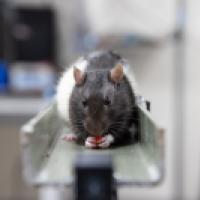Do animals have emotions? The answer is a resounding yes, according to an interdisciplinary group of animal behavior researchers from the fields of biology, psychology, anthropology and philosophy surveyed in a recent project.
“We were really struck by what we found,” said first author Matthew Zipple, Klarman fellow in the Department of Neurobiology and Behavior in the College of Arts & Sciences. “A majority of professional animal behavior researchers ascribe emotions and consciousness to a wide range of the animal taxonomy. This stands in stark contrast from the attitudes of the 20th century, when the importance of emotions in animals' lives was at best ignored and more often completely denied.”
“Animal emotions and consciousness: a preliminary assessment of researchers’ perceptions and biases and prospects for future progress” published Nov. 13 in Royal Society Open Science, provided a unique view of current scientific thought on animal emotions and consciousness.
“As far as we know, this is the first assessment of how animal behavior researchers across a range of disciplines think about emotions and consciousness in non-human animals,” said Marcela Benítez, assistant professor of anthropology at Emory University and corresponding author of the paper. “It gives us a snapshot in time so that 20 years from now, we can revisit how scientific experts may have changed their views.”
A majority of the 100 survey respondents ascribed emotions to “most” or “all or nearly all” non-human primates (98%), other mammals (89%), birds (78%), octopus, squids and cuttlefish (72%) and fish (53%). And most of the respondents ascribed emotions to at least some members of each taxonomic group of animals considered, including insects (67%) and other invertebrates (71%).
The survey found that 49% of the respondents thought the risks in animal behavioral research of anthromorphism (inaccurately projecting human experience onto animals) was a problem, while 89% thought that anthropodenial (willful blindness to any human characteristics of animals) posed a risk.
"Even within my scientific career I've sensed this shift in the way that researchers talk about emotions in animals,” Zipple said. “People seem so much more willing to engage in these questions and take them seriously than they were just a decade ago.”
The researchers developed a survey of multiple-choice questions, free-form text fields and rating scales and sent it to leading graduate school programs in animal behavior research across disciplines. They also posted solicitations for the survey on X, aimed at researchers in these fields.
The survey defined displays of animal consciousness in its most basic form, meaning that they are aware of their own existence. A majority of respondents ascribed consciousness to a broad taxonomic breadth of animals, although at slightly lower majorities as compared to emotions.
Near the end of the survey, respondents were asked to define emotion. A little more than half of their definitions referred to emotions as a response to either internal or external stimuli. A majority also referred to emotions being subjective experiences or related to consciousness or mindedness. And 40% of the responses identified emotions as functioning to motivate behaviors.
One challenge for the 100 animal researchers surveyed is which biological markers to measure and how to adequately describe and quantify something as complex and variable as emotions. They may include everything from instinctual reactions of disgust or fear to deep feelings of affection and empathy for others. Animal studies are further complicated by the fact that researchers can’t ask an animal how it’s feeling.
And while experiments with animals in labs can be tightly controlled, the results may be skewed since the animal is not interacting within its natural environment. Animal behavior experiments in the wild provide valid social and ecological contexts but they are challenging to design and to control.
Many researchers are trying to bridge that gap by studying animals in as close to their natural environments as possible. Zipple, for example, found that female mice behave very differently outside the lab, demonstrating much more complex social behaviors.
Co-authors include Mackenzie Webster, an Emory postdoctoral fellow studying cognition in nonhuman primates, and Caleb Hazelwood, a philosopher at Duke University. Researchers in the study received support from the National Science Foundation and the National Institutes of Health.






